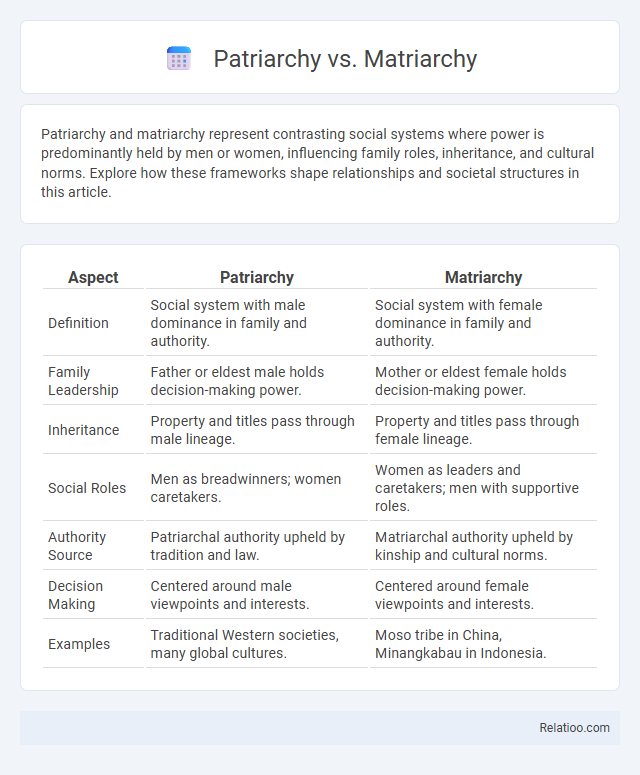Patriarchy and matriarchy represent contrasting social systems where power is predominantly held by men or women, influencing family roles, inheritance, and cultural norms. Explore how these frameworks shape relationships and societal structures in this article.
Table of Comparison
| Aspect | Patriarchy | Matriarchy |
|---|---|---|
| Definition | Social system with male dominance in family and authority. | Social system with female dominance in family and authority. |
| Family Leadership | Father or eldest male holds decision-making power. | Mother or eldest female holds decision-making power. |
| Inheritance | Property and titles pass through male lineage. | Property and titles pass through female lineage. |
| Social Roles | Men as breadwinners; women caretakers. | Women as leaders and caretakers; men with supportive roles. |
| Authority Source | Patriarchal authority upheld by tradition and law. | Matriarchal authority upheld by kinship and cultural norms. |
| Decision Making | Centered around male viewpoints and interests. | Centered around female viewpoints and interests. |
| Examples | Traditional Western societies, many global cultures. | Moso tribe in China, Minangkabau in Indonesia. |
Defining Patriarchy and Matriarchy
Patriarchy is defined as a social system where men hold primary power and predominate in roles of political leadership, moral authority, and control over property. Matriarchy, in contrast, centers authority and leadership within women, often emphasizing maternal lines and communal decision-making. Understanding these structures helps you recognize how hierarchical systems distribute power and influence across genders and social roles.
Historical Origins of Patriarchy
The historical origins of patriarchy trace back to early agricultural societies where men assumed dominant roles in property ownership, governance, and lineage, establishing systems of male authority. Patriarchy is characterized by hierarchical structures that prioritize male leadership, contrasting with matriarchal societies that center female authority and kinship. Understanding these roots sheds light on how your cultural norms and power distributions have evolved through time.
Historical Roots of Matriarchy
Matriarchy, characterized by female-centered social organization and leadership, has deep historical roots in prehistoric societies where archaeological evidence suggests women held significant power in spiritual and communal life. Unlike patriarchy, which centers male authority, matriarchal structures often emphasized kinship through maternal lines, promoting balance and communal support. Your understanding of hierarchical structures expands by recognizing that matriarchies represent an alternative form of societal organization with unique cultural and social dynamics.
Social Structure and Family Dynamics
Patriarchy typically centers power within male family members, influencing social structures by prioritizing male authority and lineage, whereas matriarchy emphasizes female leadership and inheritance, often fostering more communal family dynamics. Hierarchical structures organize individuals based on status or role, creating clear power stratifications that impact decision-making and resource distribution within both family and society. These systems shape gender roles, inheritance patterns, and social expectations, directly affecting family cohesion and societal stability.
Gender Roles and Power Distribution
Patriarchy centralizes authority with men, prescribing rigid gender roles that prioritize male dominance in social, political, and economic spheres. Matriarchy reverses these roles, positioning women as primary decision-makers and often valuing maternal lineage and communal collaboration. Hierarchical structures distribute power based on rank or status rather than gender, allowing for more fluid roles but often perpetuating inequality through rigid social stratification.
Economic Systems under Patriarchy and Matriarchy
Economic systems under patriarchy typically concentrate wealth and decision-making power in male hands, reinforcing gender-based inequalities in income and land ownership. Matriarchal economies often emphasize communal resource management and cooperative labor divisions, promoting more equitable access to wealth and social support networks. Understanding these distinctions can help you evaluate how gender dynamics influence economic structures and resource distribution in different societies.
Political Authority: Leadership in Both Systems
Patriarchy and matriarchy represent contrasting systems where political authority is predominantly held by men or women, respectively, shaping leadership roles and decision-making processes. Hierarchical structures in both systems establish clear levels of power, often centralizing leadership within a ruling individual or elite group, which reinforces authority and governance. Leadership in patriarchal societies typically emphasizes linear power transmission through male lineage, while matriarchal leadership may prioritize communal consensus and maternal lineage influence.
Cultural Narratives and Stereotypes
Cultural narratives often portray patriarchy as a system that enforces male dominance and traditional gender roles, while matriarchy is stereotypically viewed as nurturing but less authoritative. Hierarchical structures, regardless of gender focus, embed power dynamics that sustain social stratification and influence cultural norms. These stereotypes shape societal expectations and can obscure the complexity and diversity of power relations within different communities.
Modern Examples and Contemporary Influence
Patriarchy persists in many modern societies, exemplified by political systems and corporate leadership predominantly led by men, affecting Your access to power and resources. Matriarchal elements appear in certain Indigenous communities, like the Mosuo in China, where lineage and property pass through women, influencing social cohesion and gender roles. Hierarchical structures dominate contemporary organizations worldwide, from multinational corporations to governments, shaping decision-making processes and reinforcing power dynamics across multiple levels.
The future: Towards Equality or a New Paradigm?
Emerging social theories examine the evolution from patriarchy, matriarchy, and hierarchical structures towards systems emphasizing equality, inclusivity, and decentralized power. Research in gender studies and organizational behavior highlights movements challenging traditional dominance, advocating for intersectional frameworks and collaborative governance models. Future societal paradigms increasingly integrate equitable resource distribution and diverse leadership, suggesting a shift beyond binary power constructs to dynamic, context-sensitive social orders.

Infographic: Patriarchy vs Matriarchy
 relatioo.com
relatioo.com